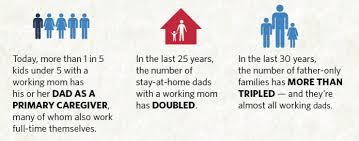Featured Article June 12, 2017

Fatherhood is not what it used to be. Back in the 1960s, American families relied on a single income, that of the dad, who spent much of his week at work while mom stayed home with the kids. Today, two-thirds of family households depend on two incomes. And the contemporary dad no longer fits neatly into the standard of the married male breadwinner and disciplinarian.
Regardless of the changing identity and priorities of the modern dad, fatherhood remains an undisputedly tough job. And a father’s ability to provide for his family is central to his role. In fact, nearly 93 percent of dads with kids younger than 18 are employed, according to the Bureau of Labor Statistics. But some working dads — those who live in states where economic opportunity abounds and quality of life is emphasized —have it better than others.
In order to determine the best states for men who play a dual role of parent and provider, WalletHub’s analysts compared the 50 U.S. states and the District of Columbia across 22 key indicators of friendliness toward working fathers. Our data set ranges from average length of work day for males to child-care costs to share of men in good or better health. Read on for our findings, expert insight on male-parenting issues and a full description of our methodology.
| Overall Rank (1 = Best) |
State | Total Score | “Economic & Social Well-Being” Rank | “Work-Life Balance” Rank | “Child Care” Rank | “Health” Rank |
|---|---|---|---|---|---|---|
| 1 | Connecticut | 72.10 | 8 | 4 | 6 | 5 |
| 2 | Minnesota | 71.17 | 2 | 9 | 5 | 1 |
| 3 | Vermont | 70.37 | 16 | 5 | 4 | 3 |
| 4 | Massachusetts | 69.12 | 11 | 11 | 3 | 2 |
| 5 | New Jersey | 68.17 | 10 | 14 | 1 | 19 |
| 6 | Rhode Island | 65.09 | 27 | 2 | 21 | 17 |
| 7 | Delaware | 64.05 | 15 | 17 | 2 | 36 |
| 8 | Wisconsin | 61.51 | 12 | 15 | 11 | 11 |
| 9 | District of Columbia | 61.10 | 17 | 7 | 30 | 18 |
| 10 | New Hampshire | 61.09 | 5 | 39 | 7 | 6 |
| 11 | Utah | 59.60 | 19 | 12 | 14 | 15 |
| 12 | Virginia | 59.34 | 3 | 44 | 8 | 14 |
| 13 | Iowa | 59.00 | 6 | 21 | 22 | 9 |
| 14 | Illinois | 58.78 | 20 | 16 | 10 | 26 |
| 15 | North Dakota | 58.30 | 1 | 38 | 15 | 20 |
| 16 | Maryland | 57.62 | 4 | 36 | 12 | 16 |
| 17 | Maine | 57.23 | 28 | 10 | 17 | 22 |
| 18 | Nebraska | 56.87 | 7 | 25 | 24 | 12 |
| 19 | Kansas | 56.21 | 13 | 27 | 18 | 25 |
| 20 | New York | 56.06 | 43 | 8 | 23 | 24 |
| 21 | Colorado | 55.06 | 18 | 20 | 28 | 7 |
| 22 | Washington | 54.75 | 25 | 13 | 31 | 8 |
| 23 | Hawaii | 54.69 | 39 | 6 | 40 | 4 |
| 24 | California | 53.40 | 49 | 1 | 47 | 10 |
| 25 | Indiana | 53.27 | 24 | 30 | 9 | 40 |
| 26 | Oregon | 53.14 | 47 | 3 | 42 | 21 |
| 27 | Ohio | 52.31 | 21 | 24 | 26 | 38 |
| 28 | Montana | 50.75 | 29 | 18 | 32 | 37 |
| 29 | Pennsylvania | 49.35 | 14 | 41 | 33 | 31 |
| 30 | Wyoming | 48.44 | 9 | 47 | 36 | 30 |
| 31 | Missouri | 48.37 | 22 | 35 | 34 | 34 |
| 32 | North Carolina | 48.18 | 38 | 31 | 20 | 35 |
| 33 | Florida | 48.18 | 46 | 23 | 19 | 27 |
| 34 | Kentucky | 47.30 | 36 | 32 | 16 | 48 |
| 35 | South Dakota | 47.17 | 23 | 42 | 38 | 13 |
| 36 | Tennessee | 46.83 | 35 | 28 | 25 | 44 |
| 37 | Michigan | 45.86 | 31 | 34 | 37 | 33 |
| 38 | Texas | 45.74 | 30 | 51 | 13 | 32 |
| 39 | Oklahoma | 42.56 | 32 | 49 | 27 | 47 |
| 40 | South Carolina | 41.82 | 42 | 40 | 35 | 42 |
| 41 | Alaska | 41.11 | 34 | 33 | 50 | 29 |
| 42 | Arizona | 40.88 | 48 | 29 | 44 | 23 |
| 43 | Georgia | 40.77 | 41 | 48 | 29 | 43 |
| 44 | Arkansas | 40.72 | 44 | 26 | 41 | 49 |
| 45 | Idaho | 39.38 | 33 | 37 | 51 | 28 |
| 46 | Alabama | 38.47 | 37 | 46 | 43 | 50 |
| 47 | Louisiana | 38.25 | 26 | 45 | 49 | 46 |
| 48 | New Mexico | 38.22 | 50 | 19 | 46 | 39 |
| 49 | West Virginia | 36.91 | 40 | 43 | 45 | 45 |
| 50 | Nevada | 35.12 | 51 | 22 | 48 | 41 |
| 51 | Mississippi | 33.78 | 45 | 50 | 39 | 51 |
Methodology
To determine the best and worst states for working dads, WalletHub’s analysts compared the 50 states and the District of Columbia across four key dimensions: 1) Economic & Social Well-Being, 2) Work-Life Balance, 3) Child Care and 4) Health.
We evaluated those dimensions using 22 relevant metrics, which are listed below with their corresponding weights. Each metric was graded on a 100-point scale, with a score of 100 representing the most favorable conditions for working dads.
We then calculated the total score for each state and the District based on its weighted average across all metrics and used the resulting scores to construct our final ranking.
Economic & Social Well-Being – Total Points: 30
- Median Family Income (Adjusted for Cost of Living): Full Weight (~7.50 Points)
Note: “Family” refers to those with kids aged 0 to 17 and in which the father is present. - Unemployment Rate for Dads with Kids Aged 0 to 17: Full Weight (~7.50 Points)
- Share of Kids Aged 0 to 17 (with Dad Present) Living in Poverty: Full Weight (~7.50 Points)
- Averaged Freshman Graduation Rate for Men: Full Weight (~7.50 Points)
Note: This metric measures the percentage of male high school students who graduated on time.
Work-Life Balance – Total Points: 30
- Parental-Leave Policy Score: Double Weight (~15.00 Points)
- Average Length of Work Day (in Hours) for Males: Full Weight (~7.50 Points)
- Average Commute Time for Men: Full Weight (~7.50 Points)
Child Care – Total Points: 30
- Day-Care Quality Score: Double Weight (~10.00 Points)
- Child-Care Costs (Adjusted for Median Family Income): Full Weight (~5.00 Points)
Note: “Family” refers to those with kids aged 0 to 17 and in which the father is present. - Pediatricians per Capita: Full Weight (~5.00 Points)
- Quality of State School System: Double Weight (~10.00 Points)
Note: This metric is based on WalletHub’s States with the Best & Worst School Systemsranking.
Health – Total Points: 10
- Male Uninsured Rate: Full Weight (~0.83 Point)
- Men’s Life Expectancy: Double Weight (~1.67 Points)
- Deaths Due to Heart Disease per 100,000 Men: Full Weight (~0.83 Point)
- Colorectal Cancer Cases per 100,000 Men: Full Weight (~0.83 Point)
- Prostate Cancer Cases per 100,000 Men: Full Weight (~0.83 Point)
- Urologists per 100,000 Men: Full Weight (~0.83 Point)
- Male Suicide Rate: Full Weight (~0.83 Point)
- Male Mental Health: Full Weight (~0.83 Point)
- Share of Men in Good or Better Health: Full Weight (~0.83 Point)
Note: This metric measures the percentage of men who reported having good or better health as part of a public health survey, data for which are collected and maintained by the Behavioral Risk Factor Surveillance System (BRFSS). - Share of Physically Active Men: Full Weight (~0.83 Point)
Note: This metric measures the percentage of men who reported engaging in adequate or any physical activity as part of a public health survey, data for which are collected and maintained by the Behavioral Risk Factor Surveillance System (BRFSS). - Unaffordability of Doctor’s Visits: Full Weight (~0.83 Point)
Note: This metric measures the percentage of men who could not afford to visit a doctor in the past 12 months due to unaffordable costs.
Sources: Data used to create this ranking were collected from the U.S. Census Bureau, Bureau of Labor Statistics, Council for Community and Economic Research, Centers for Disease Control and Prevention, National Center for Education Statistics, National Partnership for Women & Families, American Urological Association, Social Science Research Council, Child Care Aware of America and WalletHub research.















